PAGE 77a – September 2008
H O T I D E A S F O R S M A L L R A I L R O A D S

Last time we featured larger-scale, straightline shelf layouts,
so this issue is devoted to continuous circuits built in smaller scales
(from HO on down)! These examples provide plenty of ideas and inspiration
for layouts you may want to undertake. If you deduce a pattern from this progression
of themes, you’re right—we’ll be featuring small-scale shelf layouts
and larger-scale continuous circuits in the next couple issues.
This time, don’t miss the World’s Smallest Railroad Challenge (at the bottom)!
But first, we have some hot news from New Zealand…

‘ONE MAN SHOW’ OF SMALL LAYOUTS HELD IN NEW ZEALAND
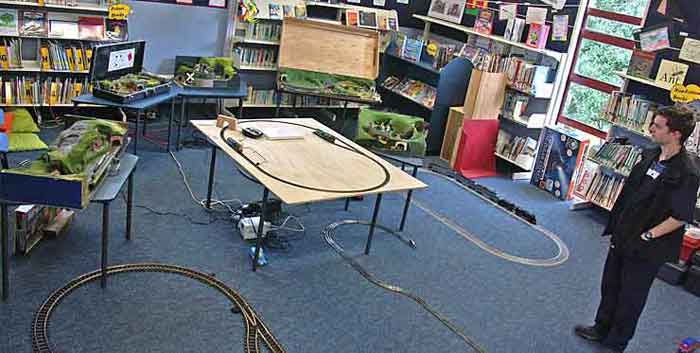
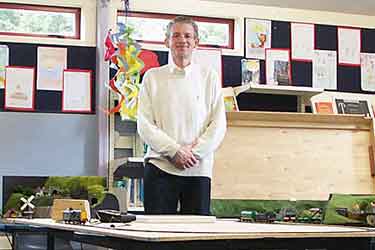 A most unusual event occurred on September 4, 2008. Jonathan Scott, who lives in Hamilton, New Zealand, held a “one man show” of micro layouts he’s built! The venue was Kaipaki School where his children—Merinda and Edwin—are studying “Technology in Toys.”Coincidentally, Jonathan was celebrating the publication of a professional paper, along with his team at the University of Waikato where he teaches electronic engineering. The paper reported on a study the team has performed of control systems for small motors, such as the ones that power model trains; the study suggests some dramatic improvements are needed in train control! The local newspaper, noting both events, covered the train show which included five micro layouts (two Z-scale and three N) from the Scott collection, three sectional layouts (two O-gauge and a G) temporarily assembled on the floor, and an HO test track used in university classes to demonstrate DCC.In the photos, university student John MacLeish (top photo) helps set up the exhibition; (above right) Jonathan poses for the cameras. There’s also a YouTube video showing how exciting the show was for the children. Several of the micro layouts on display have been featured previously in this Scrapbook, in Nos. 34, 37a and 75a.
A most unusual event occurred on September 4, 2008. Jonathan Scott, who lives in Hamilton, New Zealand, held a “one man show” of micro layouts he’s built! The venue was Kaipaki School where his children—Merinda and Edwin—are studying “Technology in Toys.”Coincidentally, Jonathan was celebrating the publication of a professional paper, along with his team at the University of Waikato where he teaches electronic engineering. The paper reported on a study the team has performed of control systems for small motors, such as the ones that power model trains; the study suggests some dramatic improvements are needed in train control! The local newspaper, noting both events, covered the train show which included five micro layouts (two Z-scale and three N) from the Scott collection, three sectional layouts (two O-gauge and a G) temporarily assembled on the floor, and an HO test track used in university classes to demonstrate DCC.In the photos, university student John MacLeish (top photo) helps set up the exhibition; (above right) Jonathan poses for the cameras. There’s also a YouTube video showing how exciting the show was for the children. Several of the micro layouts on display have been featured previously in this Scrapbook, in Nos. 34, 37a and 75a.HO (1:87): CURVED SWITCHES CREATE A SMALL, URBAN LAYOUT
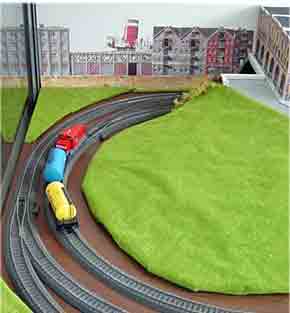
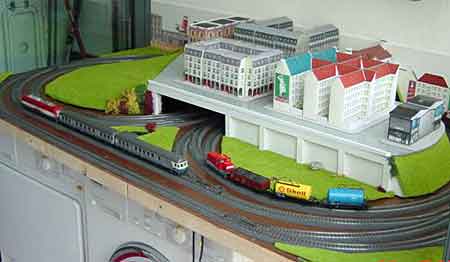
In Scrapbook #60a, Henning Stelter, from Hamburg, Germany, displayed his double-tracked pizza layout in H0 scale. Now he’s obtained a larger right-of-way in the laundry room, and is building a double-sized version—Gleisdreieck (“Triangular Junction“). Measuring just 183x100cm (72x39in), the little layout represents a typical maze of trackage found in urban centers around the world, using stock Märklin trackage.
The operating plan for the layout, shown in the track plan below, is intricate and interesting. In Henning’s words, “The idea is to have trains travelling between two interwoven reversing loops (red and green in the plan). I installed only spring switches [sprung points]. Thus, the pattern of operations indicated by the coloured arrows can be followed without throwing any switches. Dotted lines indicate sidings which are used for hiding unused trains (inner circles) or for passing and shunting (outer tracks).
“With two separate remote controls (and some patience combined with luck), it is possible to have two trains running simultaneously on the coloured tracks. Installing electronic block sections could increase the number to three. Finally, using the tracks marked by dotted lines provides more entertainment for the operators (my 4-year-old daughter and myself).”
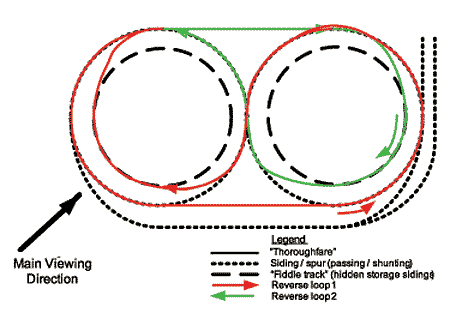
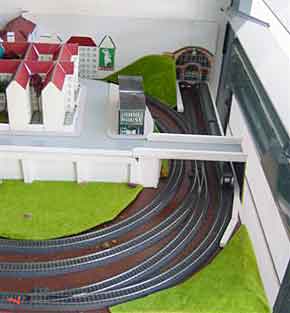

From Carl: The idea behind Henning’s layout has a long history in model railroading. A sketch from my notebooks, dated April 1953, is at right: it’s an idea by Bill Schopp in Railroad Model Craftsman for a layout interweaving two reversing loops and a passing siding using only sprung turnouts!
HO (1:87): CONTEST-WINNING LAYOUT ALREADY UNDER CONSTRUCTION!
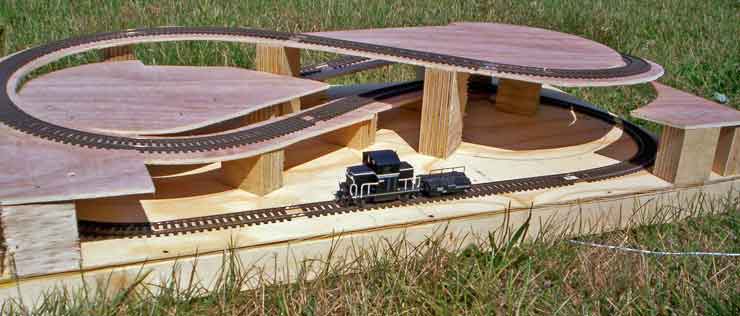
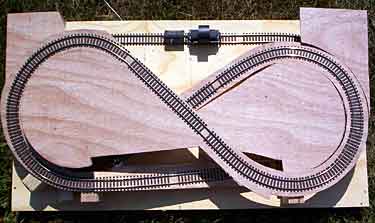
Chuck Perrucci, from Perkasie, PA USA, liked the winning layout in our Trackmobile contest so much that he built one right away! He calls his layout, like the original, Upper Douro.
Dimensions are 32x18in (82x45cm). Chuck is already running trains on the bare track and comments, “The Trackmobile will not make the grades. However my EMD Model 40 eats them up in both directions. I don’t yet have any four-wheeled rolling stock other than the gauge car, but my 34ft hoppers make it around the curves and up the grade—but only one behind the EMD.”
HOe (1:87): SLOVENIAN LAYOUT TRAVELS 800 MILES TO SHOW
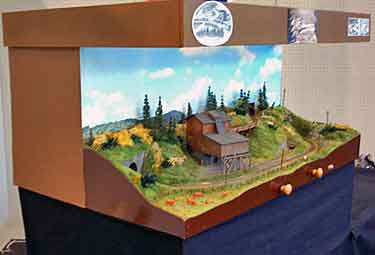
Bostjan Jarc, who lives in Novo mesto, Slovenia, found the inspiration for his H0e exhibition layout in a German narrow-gauge book: a photo of a small rock crusher building. The resulting layout, Schotterwerk (“Gravel Plant”), measures 105x70cm (41x28in). It’s a single closed circuit of track, with a seperate elevated spur to serve the crusher building. The special housing, with lighting, has 30cm (1ft) legs to sit on a table top… an idea Bostjan borrowed from British layouts.
Rolling stock is from Liliput (Bachmann), Roco, and Fleischmann, plus a pair of scratchbuilt diesel switchers. On the upper level, the little train emerges from behind the background, runs into the crusher building and dumps its load in a special bunker. Cars are exchanged by hand behind the scenes. After completion, the litle layout was transported 800 miles to Bremen for the Euromodell exhibition. Bostjan’s comment on the trip: “It should be a less heavy layout or smaller.” At the exhibition, Bostjan reports he made an “international exchange of rolling stock with British friends from the OO9 Society.” (All photos by Bostjan Jarc.)
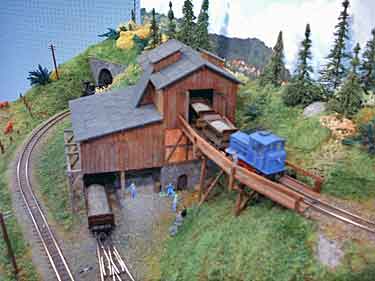
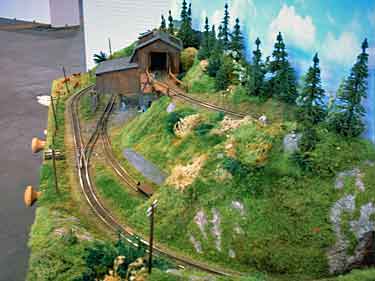
HOn30 (1:87): A TRIO OF NG DESIGNS FROM PENNSYLVANIA
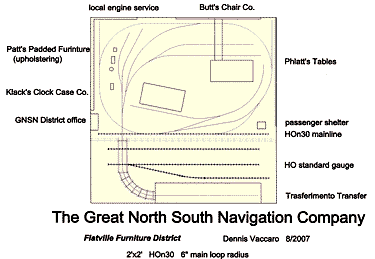
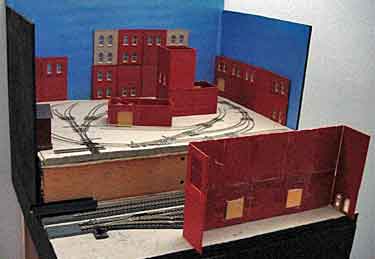
Dennis Vaccaro, from Rostraver, PA, USA, really likes big names for little layouts. He’s in the process of building the Great North South Navigation Company railroad as a series of micro layouts, each one representing a single industry. Pictured here is the Flatsville Furniture District of the GNSN RR, built as a 2x2ft (60x60cm) module that connects to Dennis’s club’s HO modular layout. The HOn30 line, however, is a self-contained operating layout that interchanges with the lower-level standard gauge tracks via the warehouse in front.
Trackage on the Furniture District is entirely handlaid, including the turnouts. There are enough sidings and switching chores to keep an operator busy for hours at a time. Narrow gauge stock can enter and exit from cassettes connected to the NG mainline tracks. “The warehouse will be open, as if you sliced through a building,” Dennis reports. “I’ll finish the inside with brick paper, concrete floors, boxes/crates/pallets, elevator, and forklifts.”
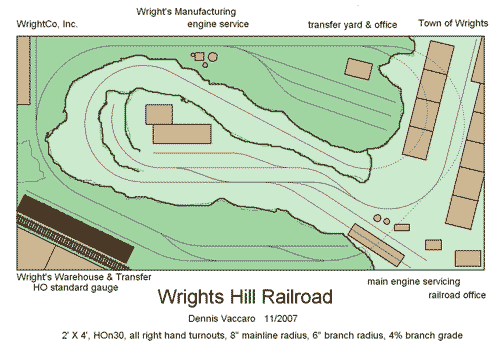
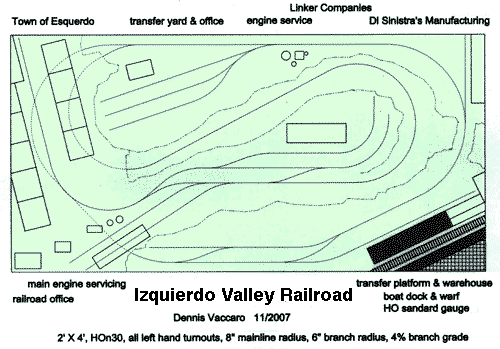
Much more complex is the tale of two layout designs that Dennis passed along as well. Here’s the story, as he tells it.
“Having been a big fan of small layouts for some time now, I picked up some HOn30 turnouts from a friend to build a layout. When I got them home, I found they were all right hand—ten of them! Rather than be discouraged, I found it quite a challenge to design a layout with switches that go only one way. Some of the things I wanted include a continuous run, a small yard, engine service facilities, runarounds, several industries, a standard gage interchange, a mountain climb, and a town.
“The layout, Wrights Hill RR, is double micro size as I wanted a longer run for the continuous loop. The design is similar to other loop-and-winding-climb layouts. The basic purpose is to shuttle parts between industries, move goods on and off the layout at the interchange, and get people to and from the town.
“Something was bothering me as I was nearing completion of the design. What happened to all the left hand turnouts? I started feeling sorry for the person that got the bag of all lefts. So, I designed a similar layout, Izquierdo Valley RR, using all lefts and using the same wish list and purposes.”
Like composing a piano concerto to be played with only one hand, these designs are a virtuoso feat!
HOn3 (1:87): WESTERN U.S. THEMED LAYOUT BUILT IN GERMANY
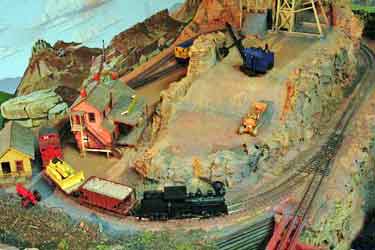
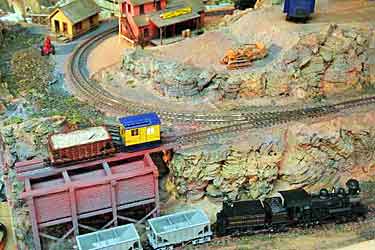
Markus Hartwig, from Pulheim-Brauweiler (near Köln/Cologne), Germany, has built his most recent H0n3 layout (1:87 on 10.5mm gauge) using an American Western narrow-gauge theme. The layout measures 1.0×0.62m (39x24in), and rolling stock is left over from previous layouts. Discussing his plans for future layouts, Markus commented, “My own experience after 40 years of model railroading is that small locomotives working on tracks smaller than H0 (or 0n30) gauge will not perform well (except Kato N machines). Maybe others have different opinions… So I plan an 0n30 mini layout now as I have fallen in love with the Bachmann shay.
“In the future I will plan and build mini layouts only, as they are the only opportunity to realize the many different plans I have.” Markus also sent along photos of a number of his past layouts in N, H0e and HOn3 scales. They can be seen at his website. We’ll look forward to seeing what this veteran modeler does in On30!
TT (1:120): CLASSIC LAYOUT SHOWCASES IMPRESSIVE MODELING

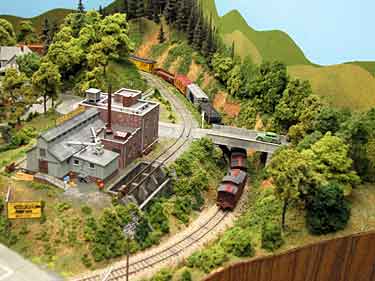
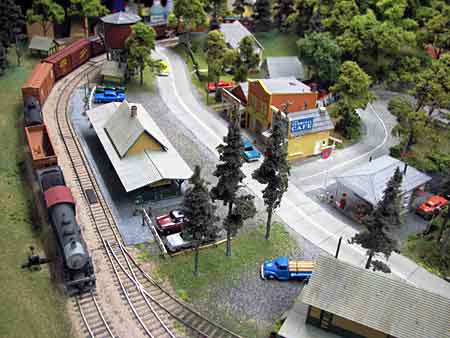
Larry Archer, from Huntington, New York USA, planned the TT scale Ticonderoga Terminal Railroad to look as if it were constructed in the 1950s—the “glory days” of TT! He was given several cartons of original TT kits from HP, Gandy Dancer and others, so he also planned to use period materials (like track, roadbed, and scenery) for the layout. The design was a classic 3x4ft (90x120cm) oval with branch siding to a factory at the back. Work started in 1990.
Reality intruded almost immediately, as the original fiber-tie track was unusable (as many people felt was the case even in the 1950s!). Larry compromised for the sake of good running and spiked Code 55 track to HOn3 wooden ties. He did stay true-to-period in the scenery material, using papier-mâché which is both strong and light.
Larry scratchbuilt several structures from Model Railroader plans published in the 1950s, then measured and modeled some other local buildings. At this point the layout no longer looked like it was made from 1950s kits, so Larry finished up with more modern materials (like Woodland Scenics foam). He concluded, “Since the only near-TT autos I could find were too late for the Steam Era, I put up a couple billboards advertising rides on the ‘Historic Steam Train.’ That should keep the nitpickers at bay.”
Ironically, after spending about five years building and detailing the Ticonderoga Terminal, Larry moved into a new, larger house with a big basement. The TTRR is now covered with plastic and stored carefully in a corner. Long time fan and collector of TT scale Jerry Golembowski, from Grandy, North Carolina USA, persuaded Larry to uncover it and dust it off earlier this year, then took these photos and sent along the information. That’s Larry at the lower right.
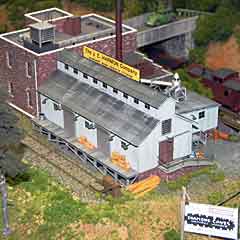

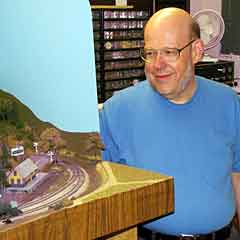
N (1:160): CANADIAN N LAYOUT SLIDES UNDER THE BED
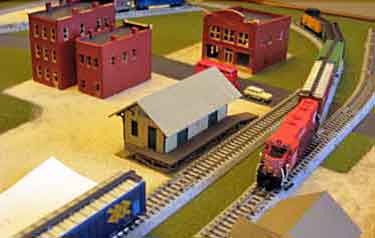 /
/ 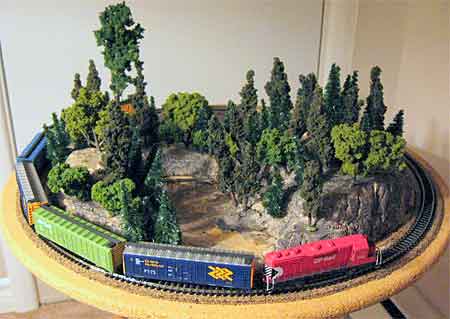
Michael-John Idzerda, from London, Ontario Canada, is building this 42x26in (107x66cm) N-scale layout to fit under the bed in his one-bedroom apartment. Says M-J, “This has been in my mind for years—a simple loop, rural scenery, few switches, industries, rock, lake, trees (a Northern Ontario thing) and all in ‘not much’ space. When I was younger, my dad built a similar layout on casters to store under my bed. That theme has been carried through: the casters allow the layout to dissapear.”
M-J is no stranger to these pages, having been featured in Scrapbook Nos. 56, 68, 70 and 72a.
N (1:160): THE ‘WELSH LOOK’ IN N STANDARD GAUGE
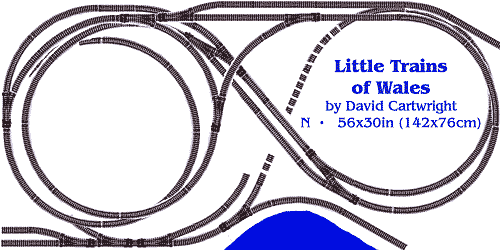
David Cartwright, from Sheffield, England, was inspired by holiday visits to the slate railways of Wales to build a model layout of his own. His N-scale design measures 56x30in (142x76cm) and was inspired by Jonathan Scott’s Pizza Hill layout in Scrapbook #37a and (top of page) in his One Man Show. David’s design has a harbour in front, mine at the top, station in the middle and most of the track in tunnels. It supports two trains running at once in opposite directions!
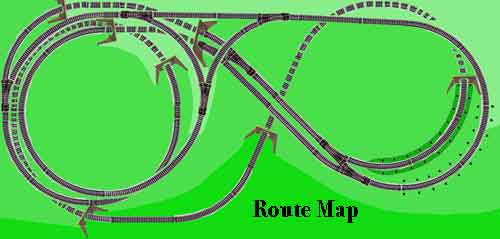
Because so many layers of track are stacked together in this complex track plan, David has kindly provided a Route Map that clearly identifies “which tracks go where.” Try tracing out the routes a train can take! Warning: this complex type of layout is generally not for beginners!
N (1:160): WHEN A U.S. O-SCALER TURNS TO GERMAN SMALL SCALE…
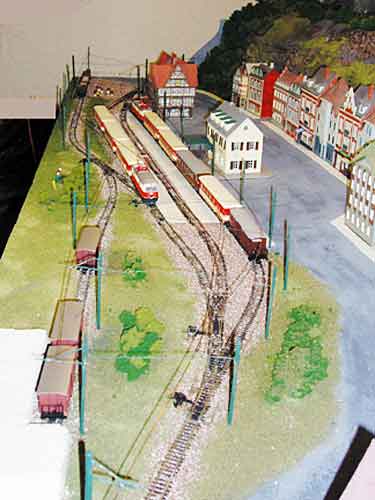
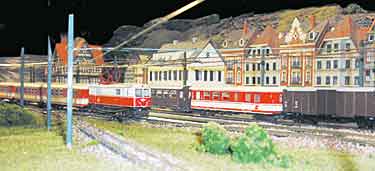
After more than 30 years modeling O-scale traction/trams, Dick Bell, from Furlong, Pennsylvania USA, went on holiday to Austria and discovered the 760mm gauge Mariazellerbahn. He was hooked, and after investing in several Roco H0e models of the line’s classic electric locomotives (1:87 running on 9mm gauge), he is building Katieburg—a portable layout in two 48x30in (120x75cm) sections that combine to make a 96x30in oval with a “typical” station in front. Round and round operation is featured, because the layout is intended for exhibition use where trains must keep running at all times.
Dick comments, “The layout is interesting to look at it from almost any perspective. By standing behind the layout you feel that you are up on the top of the mountain looking down at the little town, and at eye level from the end it is fun to watch the trains enter and depart the station as if you were trackside.”
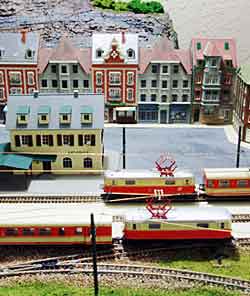
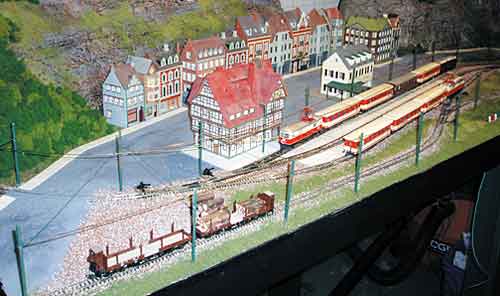
N (1:160) and Z (1:220): A TALE OF TWO LAYOUTS
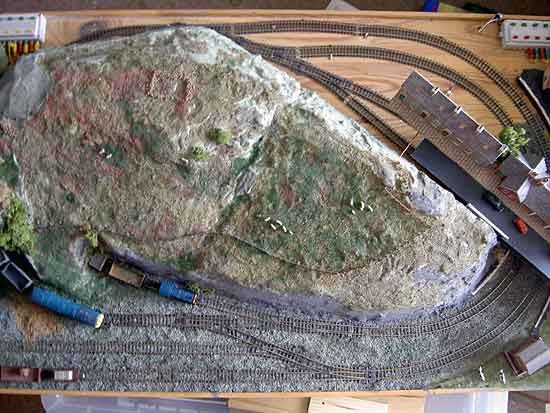
Alan Cox, who lives in Swansea, Wales, reports on two small layouts—a mature N-scale effort that is finished and about to be sold; and a new Z-scale layout that he’s currently working on. Here are his descriptions.
“Cwm Bach (Little Valley in Welsh) is a 83x50cm (32x19in) N gauge layout that squeezes a fair bit in by using some rather sharp curves, as well as having a shunting puzzle area and a half-visible loop/station that allows locomotives also to run around trains.”
The aerial photograph shows the track plan clearly. The other photos illustrate some of Alan’s effective scenery.
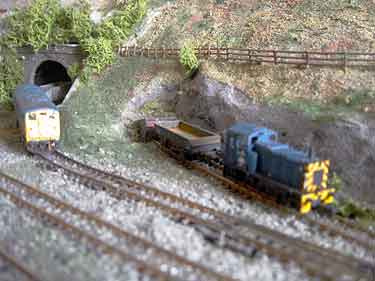
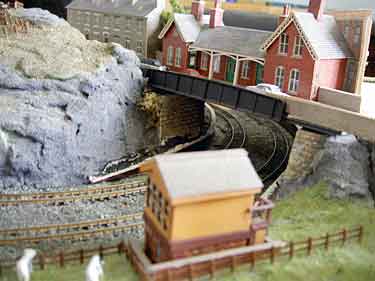
“The other (below) is a 60x40cm (24x15in) Z layout in the form of a simple loop and siding,” Alan continued. “It’s not yet finished and I need to weather and blend in some of the buildings and add bushes and stuff. The single siding actually is prototypically correct. Freight is picked up and dropped off in one direction only in accordance with small branch line practice, with freight going to the end of the branch and back if needed.
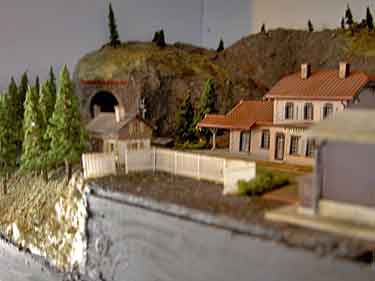
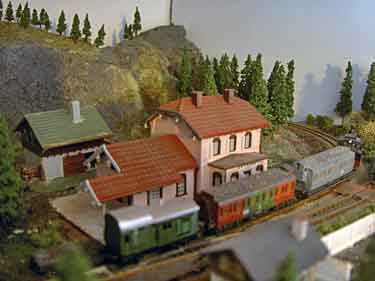
Z (1:220): SMALL LAYOUTS AT THE WGH SHOW
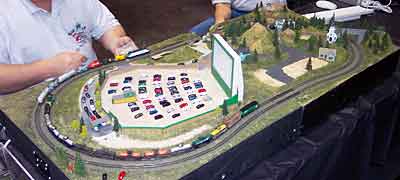
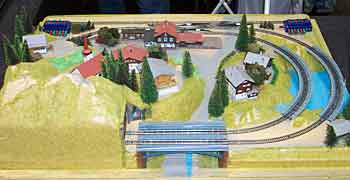
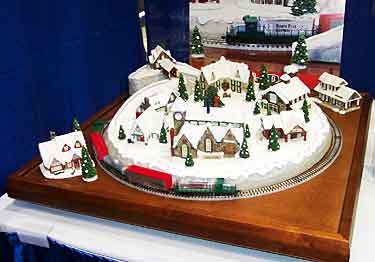
Recently William Baldwin, from Los Osos, California USA, went up to Sacramento to visit the Worlds Greatest Hobby Train Show. I asked him to take along his camera and shoot pictures of any good small layouts that he found.
“The show was not as large as I expected, but it was nice,” William reports. “From the number of young children it is to be hoped that there will be more people joining the hobby. You were correct in expecting that there would be few micro layouts present. Except for the local Z gauge group there was very little in the way of micros.” William included shots of two Z-scale micro layouts he found (above), as well as a nice photo of the new Micro-Power N Table-Top Trains and Towns (right). There were no other small layouts on display to provide inspiration, a sad outlook for future growth of the hobby.
BELOW Z: HOW SMALL CAN YOU GO?
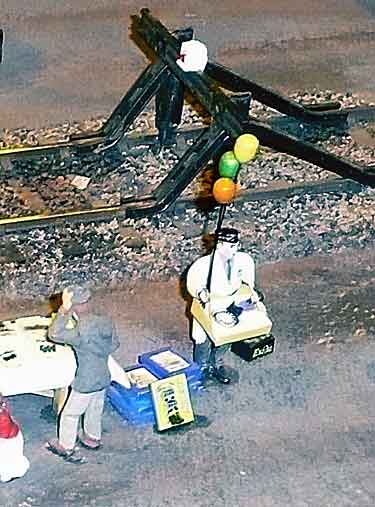
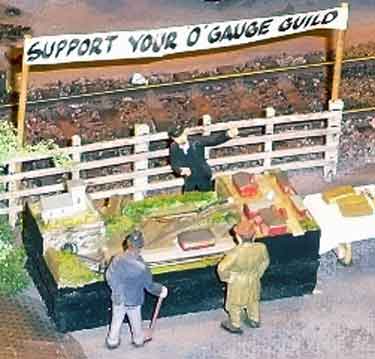
At the Bristol, England train exhibition in May, Simon Parkinson ran into Mike Renwick’s O-scale layout, Seabury Town & Preservation Society. Simon noted two “extreme micro layouts” (in O scale!) and shot these two photos.
The larger display (above), which measures roughly 80x30mm, represents a 12x4ft model railway in 7mm scale, and Mike felt it might be the world’s smallest layout. But as Simon reports, “when someone commented that they thought they had seen one smaller he made the other, much smaller, one”(right above). You can just see the circle of track on the tray in front of the balloon man! “The smaller layout is circular and is probably only 5 or 6mm in diameter (less than one scale foot), and the drive is up through his left leg and then geared to the loco.” There are many more photos of these little wonders and the Seabury Town layout here.
The layout which caused Mike to rethink his definition of “small” was the tiny affair shown in the video below. It’s an American model, roughly 13mm (half an inch) wide, representing a 4x8ft model layout in N scale! The builder is David K. Smith, and his website shows and tells much more about this engineering feat.
The question: is one of these marvels the world’s smallest model railroad? My answer is “No, they’re wonderfully well done, but they’re mechanical toys, not model railroad layouts.” To elucidate further, and to kick off a search for the World’s Smallest Working Model Railroad, we are introducing a new Challenge. Read on!
World’s Smallest Working Model Railroad
CHALLENGE!
Seems to me there are two important authenticity tests that must be met by the World’s Smallest Working Model Railroad:
- It must use flanged wheels running on rails (that’s a basic definition of a “railroad”).
- It must actually operate: you must be able to run laps or switch/shunt a car to a different track. (Thanks to Tyson Rayles for this definition of a “layout”!)
Given those tests for authenticity, what is the world’s smallest working model railroad? Many extremely tiny models have been constructed (see article above), but the ones I’ve seen fail one of more of these tests. So to find the smallest, here’s a new Challenge!
Readers are challenged to send examples of very small layouts to webmaster-AT-carendt-DOT-us (replace “-AT-” and “-DOT-” with the appropriate symbols). If you’re submitting someone else’s work, please identify the originator (with, if possible, a Web reference). And feel free to design your own! Any conceptual design, an unusual idea that has not yet been built, must also include a “proof of concept”—either build the thing or create a mockup to demonstrate that it will work. Send photos and/or drawings (including size indicators), not the models themselves.
All entries will be acknowledged, and the entrant of the tiniest one (measured by its cubic area—footprint x height) will receive a very small prize along with considerable acclaim in these pages. Entries must meet both of the authenticity tests, should have at least minimal scenery, and must be received before midnight U.S. Eastern time (GMT – 5), 30 November 2008. (Note that earlier entries may be published before the Challenge ends, to spur everyone’s creativity!)
In Addition:
Several readers have insisted that “smallness” is always relative to scale. Though I disagree, this challenge will also recognize the layout entry that is the smallest relative to its gauge. A second very small prize will be awarded to the proportionally smallest working layout design submitted in any of the commercially-available gauges… from 45mm (1¾in) down to 6.5mm (or is it now 3mm?). Size will be measured as a ratio of the layout’s longest dimension to the gauge: for example, an HO-gauge (16.5mm gauge) layout measuring 165x48x34mm would have a ratio of 10:1. (In the case of ties, the ratio of the second longest dimension will decide the winner.) Scale of the models is optional, only the gauge will be used for proportional size comparisons.
The same two authenticity tests will apply to all entries, and the submission deadline for all is midnight U.S. Eastern time (GMT-5) on 30 November 2008.
—Carl Arendt
Leave a Reply